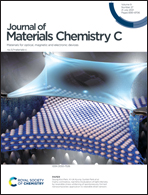Frustrated structures and pattern formation after thermal quenches in cholesteric liquid crystal droplets†
Abstract
The complex arrangement of layered structures in curved geometries is a ubiquitous problem in soft condensed matter systems. In general, cholesteric liquid crystals (CLCs) in spherical droplets have been studied in the literature by means of the Landau-de Gennes (LdG) simulation method, which often need Ansatz structures to reach stable states. In this paper, we successfully achieved different organizations of CLC droplets by performing thermal quenches under several combinations of elastic constants and anchoring energy as chirality is increased by using a chiral pairwise additive potential interpreted in terms of Monte Carlo (MC) simulations. We describe well-known structures for planar and homeotropic alignment that were quenched from random states, including some high chirality regime droplets. The method proposed here represents an easier to implement and faster to execute simulation method, that demands considerably low computational power, to study the complex arrangement of layered structures such as CLCs in complex geometries. It has the advantage, when compared to the LdG method for example, of naturally contemplating the role played by thermal fluctuations and elastic anisotropy. Furthermore, it finally allows studies involving thermal quenching of CLC droplets, starting from a random state, to reach stable states.



 Please wait while we load your content...
Please wait while we load your content...